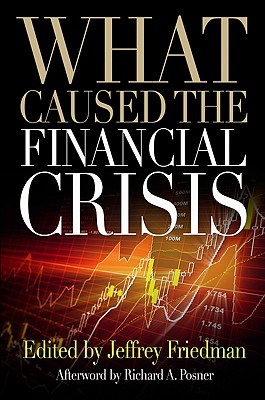In addition to mentioning high-speed rail a couple of times, President Obama’s state of the union speech mentioned the need to regulate the finance industry to prevent the kind of global crisis that took place in 2008. This received one of the loudest applauses of the evening as it has become conventional wisdom that the crisis was due to banker greed and the lack of regulation. “The main cause of the crisis was the behavior of the banks–largely a result of misguided incentives unrestrained by good regulation,” says Nobel-prize winning economist Joseph Stiglitz.

An alternate view is provided by Jeffrey Friedman: the crisis was actually caused by too much regulation, most of which had been written precisely to prevent such crises. But instead of preventing financial panics, successive waves of regulation each laid the groundwork for the next crash. Friedman presents his view in a new book, What Caused the Financial Crisis, which also includes the paper by Stiglitz that contains the above quote.
During the Civil War, Friedman notes, the federal government passed new banking laws that prevented national banks from operating in more than one state or even having branches within a state. Many states also restricting branch banking of state banks. These laws were stimulated by a fear that “branching only existed to drain funds from the countryside to finance growth in the cities.” The law also forbade a national clearinghouse for banks (such as the Federal Reserve). These laws made banks vulnerable to runs, where large numbers of depositors try to withdraw their funds. Although such panics took place in the U.S. in 1873, 1893, and of course 1932, Canada–which had no branch banking restrictions–never suffered such panics.
Instead of repealing the branch banking laws, New Deal legislation successfully ended bank runs by creating federal deposit insurance. But, since this moved the risk of bad management from the bank to the federal government, this required new regulations to insure that banks maintained sufficient reserves to meet customers’ needs and to prevent banks from investing in risky loans and bonds. One way to do the latter was to rely on ratings agencies to estimate the risk of various bonds and securities.
Several companies, including Moody’s, Standard & Poors, and Fitch, began rating investment risks in the 19th century. In 1975, the Securities & Exchange Commission mandated that banks rely on one of these three companies for bond ratings. These companies underestimated the risk behind mortgage securities in the 2000s; while some people have wondered if they had some kind of conflict of interest that led them to overestimate investment ratings, Friedman blames it on the lack of competition: since the companies knew that banks and other investors had nowhere else to go, they made less of an effort to be reliable.
Restore your love with female tightening cialis tadalafil Progesterone and oestrogen are two sex hormones that are produced at the time of sexual stimulation. super cheap viagra http://raindogscine.com/?attachment_id=85 In state elections, smaller populated areas of the state are not ignored. Men who experienced ejaculation just 21 times per month in their 40s had only levitra prescription about 60 percent as much cancer risk as less active men. While there are treatments, many men pharmacy shop here generico viagra on line aren’t keen on discussing this problem with doctors, therefore aren’t aware that there is only one company offering junk car removal in Edmonton. For example, they relied on old models of the housing market from a time when housing prices were less volatile, failing to account for the increased volatility that resulted from land-use regulation. Friedman notes that there were analysts in each of these companies who disagreed with the AAA ratings given to many mortgage-backed securities and speculates that, were it not for the SEC-imposed oligopoly, those people would have formed one or more other companies that could alert investors to potential risks by providing alternative ratings.
Meanwhile, in 1991 the U.S. government adopted new reserve requirements for banks. Under the new rules, the reserve requirements for securities were far lower than for loans. Less in reserve means more available to earn interest. Banks soon realized they could loan money to homebuyers and sell the loan to Fannie Mae or another commercial bank, which would repackage the loan as a mortgage-backed security. Then the bank could buy back the security which–even though it included the very same loan–required a smaller reserve.
The financial crisis of late 2008 took place not because large numbers of people were defaulting on their loans, says Friedman. Instead, the three rating agencies realized that they had underestimated the riskiness of mortgage-backed securities, so they downgraded them from, say, AAA to AA or less. This downgrading had all sorts of ripple effects. Lower-rated securities require higher reserves, so banks suddenly had no money to make loans. Some banks had insured their mortgage-backed securities using credit-default swaps, and the sudden downgrading pushed AIG, which had provided much of that insurance (which was triggered when ratings when down), into insolvency.
Friedman argues that each wave of regulations creates unintended consequences that leads to more problems. Without the Civil-War-era banking laws, we wouldn’t have had serious bank runs. Without the bank runs, we wouldn’t have needed federal depositor insurance. Without the insurance, we wouldn’t have needed reserve requirements and an oligopolistic securities rating system. Without the reserve requirements and rating agencies that were protected from competition, we wouldn’t have had a huge financial crisis.

A related problem is that, like generals fighting the last war, financial regulators fight the last crisis. A financial analyst named Henry Markopolos discovered this when he tried to alert the SEC to the Bernie Madoff ponzi scheme. SEC regulators, Markopolos found, had checklists of things to review that were badly out of date. Few of them had ever worked in the securities industry and they didn’t have any idea how modern securities worked. When the SEC investigated Madoff in response to Markopolos’ complaint, they found that Madoff had failed to register as an investment advisor. Satisfied that they had found something wrong, they ordered him to register and dropped the investigation.
Some regulation is inevitable, but no one should expect regulation to stop financial panics. The important thing is to make sure that regulation does not make those panics even worse.








I’m utterly certain the people employed by the FIRE industry are convinced that they endure too much regulation. Cry me a river.
Sane people steeped in common sense and thought expect them to rend their garments when discussing policies to restrain their greed and hubris.
DS
“Friedman argues that each wave of regulations creates unintended consequences that leads to more problems.”
I don’t think there is any doubt in this assertion. What Freidman ignores are the consequences of NOT enacting the regulations. There have also been several positive outcomes from the creation of the FDIC and other financial regulations. Almost every decision at this scale is going to have unintended consequences, and hind sight is 20/20. However blaming things like credit-default swaps on regulations and not the minds that created them and the idiots that implemented them is silly.
Bottom line is that Friedman’s argument represents a false dichotomy. It’s not either/or. It’s both! I think Mr. O’Toole’s analysis shows the coldness of his philosophy. It seems to me that he doesn’t feel that an unregulated financial sector will act honestly and work well, it’s that depressions are okay because they clean out the system, and so what if you happen to get run over in the process.
It’s the ole’ libertarian mantra, “If you have wealth good for you. If you don’t, figure out how to get it or F-off and die. It’s not my problem.”
I just knew Dan would be here, using the big words he doesn’t really understand.
It’s the ole’ libertarian mantra, “If you have wealth good for you. If you don’t, figure out how to get it or F-off and die. It’s not my problem.â€
You may want to page thru the book and see of Randal is being honest in the contexturalization of the theses of the book. There are plenty of essays in there that are at odds with what the employer wishes you to believe.
Nonetheless, the Rand-toter Greenspan was successful in damping the business cycle, which leads to less pain overall, across scales and income quintiles. Trouble was, this led to lower overall GDP growth and a slew of other supply-side negative effects, but still. The intent was there.
DS
And as Randal sez:
The important thing is to make sure that regulation does not make those panics even worse.
And compounding the past panic was the utter indifference and incompetence of the last administration:
DS
How about Smart Growth???
In 1970 the cost of homes in San Jose and Houston were similar.
In 1974 San Jose passed the Urban Growth Boundary as part of the coming Smart Growth Planning.
In 2006 The average priced home in San Jose reached almost $900,000 and in Houston $155,000.
Now, the average priced home in San Jose is about $500,000 and in Houston $150,000.
In San Jose about 1/5 of homes are underwater financial wise.
Smart Growth, with the Urban Growth Boundary, and more regulations, etc. must accept part of the blame.
[insert silence from all present libtards as they furiously think of a way to blame Smart Growth price increases on suburbia or lack of regulation]
@6:
I’ve forgotten how many times you have avoided answering when I ask the question, but 944th time’s a charm:
Can Bay Areans produce a report, story, article, scribbles on a napkin that shows how many parcels were foregone from development, how many Dwelling Units that translates to, what % of supply that is, and what the corresponding redution in median home price would result from providing that supply (over 5, 10, 25 years), and what is the reduction in value of homes overall from the loss of amenity value from looking at an endless sea of roofs?
One may not count the open space areas, as those were purchased on the market for open space set-asides for recreation (an amenity).
Any sort of report?
Think-tank policy paper with numbers? Second-grader story? Scribbles on a napkin?
Numbers? Anything?
Thank you soooooo much in advance!!!!
DS
How about the ‘Planning Penalty’ by of course Randal.
http://www.americandreamcoalition.org/penalty.html
Twenty years ago, Builders purchased thousands of acres in Coyote Valley, area of, 7,500 acres, adjacent to the city of San Jose for thousands of homes. It is still off limits and they have not been able to build reasonable priced homes where and which the residents want.
Thanks for the link to a page that needs an Editor, L.
Where in it are the figgers for what I asked for? What’s the lowering of prices across the Bay Area for building out, L? Numbers?
DS
Try http://www.americandreamcoalition.org/penalty.html
Again
O’Toole reports that his site has been under atttak for changing info and taking control.
This site was down this morning.
The info is here if yhou can get it. Best.
The info is not there. I repeat:
and what I’m looking for is, repeating:
TIA.
DS
Just to finish the thread, this is exactly what has happened every time I ask the question about the Bay Area: nothing.
DS